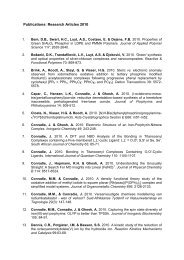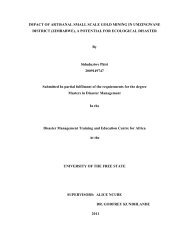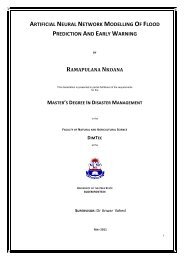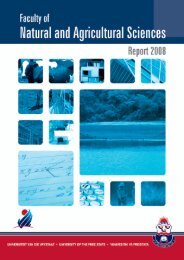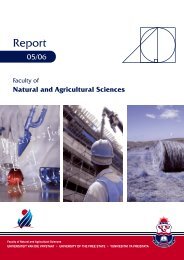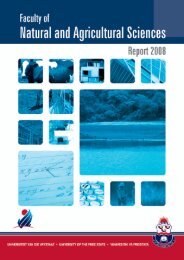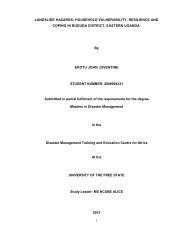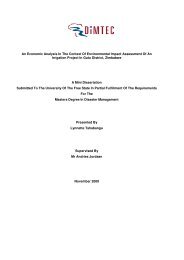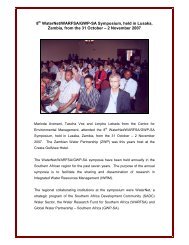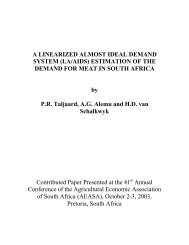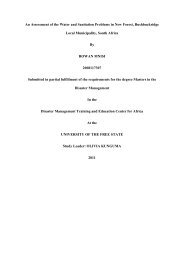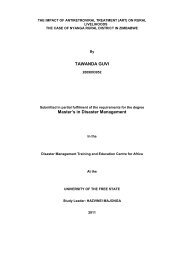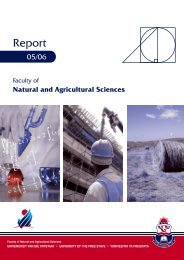D. Bhebhe - Faculty of Natural and Agricultural Sciences - University ...
D. Bhebhe - Faculty of Natural and Agricultural Sciences - University ...
D. Bhebhe - Faculty of Natural and Agricultural Sciences - University ...
You also want an ePaper? Increase the reach of your titles
YUMPU automatically turns print PDFs into web optimized ePapers that Google loves.
Working in the dry season (120 working days) this translates to between 883 <strong>and</strong> 4.667 full<br />
time labourers. At an average wage <strong>of</strong> Z$200 per month (or Z$ 1 200 for six months) these<br />
replacement costs range from Z$1.1 million to Z$560 million (Rea, 1994).<br />
With twice the number <strong>of</strong> panners, the estimated cost <strong>of</strong> moving the material would double to<br />
between Z$2.2 million <strong>and</strong> $11.2 million for one year.<br />
These costs only include labour for moving material out <strong>of</strong> the river <strong>and</strong> distributing it. Other<br />
costs for a more complete rehabilitation programme would be incurred for example, to rebuild<br />
riverbanks, protect high-risk banks with rocks, <strong>and</strong> terrace slopes <strong>and</strong> plant vetiver grass <strong>and</strong><br />
trees. If carried out by social crew, this additional activity could cost an estimated $10 per<br />
meter <strong>of</strong> river length, with both sides <strong>of</strong> the river being treated at an average height <strong>of</strong> 2<br />
meters. The cost is based on two men working at Z$10.00 per day/man, plus additional costs<br />
for vetiver grass, equipment such as wheelbarrows <strong>and</strong> shovels <strong>and</strong> general overheads. For<br />
every kilometer <strong>of</strong> river rehabilitated, the cost could be in the range <strong>of</strong> $10 000.<br />
Given the significance <strong>of</strong> gold panning in the province <strong>and</strong> the large number <strong>of</strong> rivers being<br />
damaged, the cost <strong>of</strong> follow-up rehabilitation would be enormous, even with this simple,<br />
labour intensive method. For example, using the conservative figure <strong>of</strong> 500 km <strong>of</strong> rivers in<br />
the province, the cost <strong>of</strong> full restoration is $0.5 million. With a more realistic figure <strong>of</strong> 1<br />
000km <strong>of</strong> rivers <strong>and</strong> tributaries in the province under siege at various times <strong>of</strong> the year, the<br />
cost could be $10.0 million. These costs are order <strong>of</strong> magnitude estimates only. To be<br />
consistent with assumptions about the number <strong>of</strong> panners, we can assign costs <strong>of</strong> $5.0 million<br />
for the estimate <strong>of</strong> 2.000 panners <strong>and</strong> $10.0 million for 4.000 panners.<br />
Other estimation methods for siltation could be used if better data were available. For<br />
example, the lost income from lower crop yields due to reduced irrigation water supplies<br />
(effect on production approach) or the cost <strong>of</strong> dragging dams for building new dams<br />
(replacement cost) could be used (Belli, 1989).<br />
37



